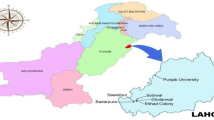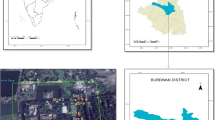Abstract
Due to the different responses to air pollutants, plants could be used as the bio-monitors to estimate the air pollution. The air pollution tolerance index, calculated by ascorbic acid content, relative water content, leaf extract pH and total leaf chlorophyll content, is a very important tool to select the sensitive species as bio-indicator of air pollution. In the present study, the air pollution tolerance indexes of four evergreen tree species collected from different polluted areas in Xi'an city were evaluated to determine the sensitivity degrees of trees to air pollutants and their performance in urban areas. Moreover, the anticipated performance index was calculated by combining the air pollution tolerance index values with some relevant socioeconomic and biological characteristics. The results showed that the highest air pollution tolerance indexes were Cedrus deodara and Sabina chinensis, and it was determined that the species with very good performance was Cedrus deodara. On the other hand, the species with the most sensitive and poor performance were Ligustrum lucidum and Euonymus japonicas. All the results exhibited that Ligustrum lucidum and Euonymus japonicas could be effectively used as bio-indicators of air pollution, and Cedrus deodara was the appropriate tree species for green belt development in Xi'an, China.



Similar content being viewed by others
Data and materials availability
All data generated or analyzed during this study are included in this published article and its supplementary information files.
References
Arnon DI (1949) Copper enzymes in isolated chloroplasts. Polyphenoloxidase Beta Vulgaris Plant Physiol 24(1):1–15
Bhadauria S, Dixit A, Singh D (2022) Estimation of air pollution tolerance and anticipated performance index of roadside plants along the national highway in a tropical urban city. Environ Monit Assess 194:808. https://doi.org/10.1007/s10661-022-10483-0
Dadkhah-Aghdash H, Rasouli M, Rasouli K, Salimi A (2022) Detection of urban trees sensitivity to air pollution using physiological and biochemical leaf traits in Tehran. Iran Sci Rep 12(1):15398. https://doi.org/10.1038/s41598-022-19865-3
Escobedo FJ, Wagner JE, Nowak DJ, De la Maza CL, Rodriguez M, Crane DE (2008) Analyzing the cost effectiveness of Santiago, Chile’s policy of using urban forests to improve air quality. J Environ Manag 86(1):148–157. https://doi.org/10.1016/j.jenvman.2006.11.029
Flowers MD, Fiscus EL, Burkey KO, Booker FL, Dubois JJB (2007) Photosynthesis, chlorophyll fluorescence, and yield of snap bean (Phaseolus vulgaris L.) genotypes differing in sensitivity to ozone. Environ Exp Bot 61(2):190–198. https://doi.org/10.1016/j.envexpbot.2007.05.009
Ghafari S, Kaviani B, Sedaghathoor S (2021) Assessment of air pollution tolerance index (APTI) for some ornamental woody species in green space of humid temperate region (Rasht, Iran). Environ Dev Sustain 23(3):4747–4748. https://doi.org/10.1007/s10668-020-01098-x
Goswami M, Kumar V, Kumar P, Singh N (2022) Prediction models for evaluating the impacts of ambient air pollutants on the biochemical response of selected tree species of Haridwar. India Environ Monit Assess 194:696. https://doi.org/10.1007/s10661-022-10384-2
Govindaraju M, Ganeshkumar RS, Muthukumaran VR, Visvanathan P (2012) Identification and evaluation of air-pollution-tolerant plants around lignite-based thermal power station for greenbelt development. Environ Sci Pollut Res Int 19(4):1210–1223. https://doi.org/10.1007/s11356-011-0637-7
Hajizadeh Y, Mokhtari M, Faraji M, Abdolahnejad A, Mohammadi A (2019) Biomonitoring of airborne metals using tree leaves: protocol for biomonitor selection and spatial trend. MethodsX 6:1694–1700. https://doi.org/10.1016/j.mex.2019.07.019
Hariram M, Sahu R, Elumalai SP (2018) Impact assessment of atmospheric dust on foliage pigments and pollution resistances of plants grown nearby coal based thermal power plants. Arch Environ Contam Toxicol 74(1):56–70. https://doi.org/10.1007/s00244-017-0446-1
Iqbal M, Mahmooduzzafar NF, Khan PR (2010) Photosynthetic, metabolic and growth responses of Triumfetta rhomboidea to coal-smoke pollution at different stages of plant ontogeny. J Plant Interact 5(1):11–19. https://doi.org/10.1080/17429140902996165
Javanmard Z, Kouchaksaraei MT, Hosseini SM, Pandey AK (2020) Assessment of anticipated performance index of some deciduous. Environ Sci Pollut Res 27(31):38987–38994. https://doi.org/10.1007/s11356-020-09957-w
Joshi PC, Swami A (2007) Physiological responses of some tree species under roadside automobile pollution stres around city of Haridwar India. Environmentalist 27(3):365–374. https://doi.org/10.1007/s10669-007-9049-0
Jyothi SJ, Jaya DS (2010) Evaluation of air pollution tolerance index of selected plant species along roadsides in Thiruvananthapuram. Kerala J Environ Biol 31(3):379–386. https://doi.org/10.2112/JCOASTRES-D-09-00120.1
Karmakar D, Padhy PK (2019) Air pollution tolerance, anticipated performance, and metal accumulation indices of plant species for greenbelt development in urban industrial area. Chemosphere 237:124522. https://doi.org/10.1016/j.chemosphere.2019.124522
Kashyap R, Sharma R, Uniyal SK (2018) Bioindicator responses and performance of plant species along a vehicular pollution gradient in western Himalaya. Environ Monit Assess 190:302. https://doi.org/10.1007/s10661-018-6682-7
Kaur M, Nagpal AK (2017) Evaluation of air pollution tolerance index and anticipated performance index of plants and their application in development of green space along the urban areas. Environ Sci Pollut Res 24(23):18881–18895. https://doi.org/10.1007/s11356-017-9500-9
Keller T, Schwager H (1977) Air pollution and ascorbic acid. Eur J Forest Pathol 7(6):338–350. https://doi.org/10.1111/j.1439-0329.1977.tb00603.x
Khanoranga KS (2019) Phytomonitoring of air pollution around brick kilns in Balochistan province Pakistan through air pollution index and metal accumulation index. J Clean Prod 229:727–738. https://doi.org/10.1016/j.jclepro.2019.05.050
Klumpp G, Furlan CM, Domingos M, Klumpp A (2000) Response of stress indicators and growth parameters of Tibouchina pulchra Cogn exposed to air and soil pollution near the industrial complex of Cubatão Brazil. Sci Total Environ 246(1):79–91. https://doi.org/10.1016/S0048-9697(99)00453-2
Kwak MJ, Lee JK, Park S, Lim Y, Kim H, Kim KN, Woo SY (2020) Evaluation of the importance of some East Asian tree species for refinement of air quality by estimating air pollution tolerance index, anticipated performance index, and air pollutant uptake. Sustainability 12:3067. https://doi.org/10.3390/su12073067
Malav LC, Kumar S, IslamChaudhary SP, Khan SA (2022) Assessing the environmental impact of air pollution on crops by monitoring air pollution toleranc, index (APTI) and anticipated performance index (API). Environ Sci Pollut Res 29:50427–50442. https://doi.org/10.1007/s11356-022-19505-3
Molnar VE, Simon E, Tothmeresz B, Ninsawat S, Szabo S (2020) Air pollution induced vegetation stress–The air pollution tolerance index as a quick tool for city health evaluation. Ecol Indic 113:106234. https://doi.org/10.1016/J.Ecolind.2020.106234
Mulay JR (2020) Roadside plants as bio-indicators of urban air pollution. Int J Sci Res Sci Technol 7(10):321–326. https://doi.org/10.32628/IJSRST1207482
Nadgórska-Socha A, Kandziora-Ciupa M, Trzęsicki M, Barczyk G (2017) Air pollution tolerance Index and heavy metal bioaccumulation in selected plant species from urban biotopes. Chemosphere 183:471–482. https://doi.org/10.1016/j.chemosphere.2017.05.128
Nowak DJ, Crane DE, Stevens JC (2006) Air pollution removal by urban trees and shrubs in the United States. Urban for Urban Green 4(3):115–123. https://doi.org/10.1016/j.ufug.2006.01.007
Nowak DJ, Hirabayashi S, Doyle M, McGovern M, Pasher J (2018) Air pollution removal by urban forests in Canada and its effect on air quality and human health. Urban for Urban Green 29:40–48. https://doi.org/10.1016/j.ufug.2017.10.019
Ogunkunle CO, Suleiman LB, Oyedeji S, Awotoye OO, Fatoba PO (2015) Assessing the air pollution tolerance index and anticipated performance index of some tree species for biomonitoring environmental health. Agrofor Syst 89(3):447–454. https://doi.org/10.1007/s10457-014-9781-7
Pandey J, Agrawal M (1994) Evaluation of air pollution phytotoxicity in a seasonally dry tropical urban environment using three woody perennials. New Phytol 126(1):53–61. https://doi.org/10.1111/j.1469-8137.1994.tb07529.x
Pandey AK, Pandey M, Tripathi BD (2016) Assessment of air pollution tolerance index of some plants to develop vertical gardens near street canyons of a polluted tropical city. Ecotoxicol Environ Saf 134:358–364. https://doi.org/10.1016/j.ecoenv.2015.08.028i
Patel K, Chaurasia M, Rao KS (2022) Urban dust pollution tolerance indices of selected plant species for development of urban greenery in Delhi. Environ Monit Assess 195:16. https://doi.org/10.1007/s10661-022-10608-5
Pathak V, Tripathi BD, Mishra VK (2011) Evaluation of anticipated performance index of some tree species for green belt development to mitigate traffic generated noise. Urban for Urban Green 10(1):61–66. https://doi.org/10.1016/j.ufug.2010.06.008
Prajapati SK, Tripathi BD (2008) Anticipated performance index of some tree species considered for green belt development in and around an urban area: a case study of Varanasi city, India. J Environ Manag 88:1343–1349
Prasad BJ, Rao DN (1982) Relative sensitivity of a leguminous and a cereal crop to sulphur dioxide pollution. Environ Pollut 29(1):57–70. https://doi.org/10.1016/0143-1471(82)90054-X
Qiu Y, Guan D, Song W, Huang K (2009) Capture of heavy metals and sulfur by foliar dust in urban Huizhou, Guangdong Province. China Chemosphere 75(4):447–452. https://doi.org/10.1016/j.chemosphere.2008.12.061
Qu XY, Zhang TY, Gao TE, Lui R, Bao KW, Li T (2019) The relationship between the atmospheric particle-retaining capabilities of 10 evergreen plants and their leaf surface micro-morphology. J Shaanxi Normal Univ (Natural Science Edition). 43(3):84–90. https://doi.org/10.15983/j.cnki.jsnu.2019.03.332
Rai PK, Panda LL (2014) Dust capturing potential and air pollution tolerance index (APTI) of some road side tree vegetation in Aizawl, Mizoram, India: an Indo-Burma hot spot region. Air Qual Atmos Health 7(1):93–101. https://doi.org/10.1007/s11869-013-0217-8
Roy A, Bhattacharya T, Kumari M (2020) Air pollution tolerance, metal accumulation and dust capturing capacity of common tropical trees in commercial and industrial sites. Sci Total Environ 722:137622. https://doi.org/10.1016/j.scitotenv.2020.137622
Sahu C, Basti S, Sahu SK (2020) Air pollution tolerance index (APTI) and expected performance index (EPI) of trees in sambalpur town of India. SN Appl Sci 2(8):1327. https://doi.org/10.1007/s42452-020-3120-6
Simon E, Molnár VÉ, Lajtos D, Bibi D, Tóthmérész B, Szabó S (2022) Usefulness of tree species as urban health indicators. Plants (basel) 10(12):2797. https://doi.org/10.3390/plants10122797
Tripathi AK, Gautam M (2007) Biochemical parameters of plants as indicators of air pollution. J Environ Biol 28(1):127–132
Watson AS, Bai RS (2021) Phytoremediation for urban landscaping and air pollution control—a case study in Trivandrum city, Kerala, India. Environ Sci Pollut Res 28:9979–9990. https://doi.org/10.1007/s11356-020-11131-1
Wong NH, Tan AYK, Chen Y, Sekar K, Tan PY, Chan D, Wong NC (2010) Thermal evaluation of vertical greenery systems for building walls. Build Environ 45(3):663–672. https://doi.org/10.1016/j.buildenv.2009.08.005
Yadav R, Pandey P (2020) Assessment of air pollution tolerance index (APTI) and anticipated performance index (API) of roadside plants for the development of greenbelt in Urban Area of Bathinda City, Punjab, India. Bull Environ Contam Toxicol 105:906–914. https://doi.org/10.1007/s00128-020-03027-0
Acknowledgements
The authors are very grateful for financial supports from the Soft science project of Xi'an science and technology bureau (No. SF1505(8)), and the anonymous reviewers’ constructive comments and feedback.
Funding
This work was supported by Soft science project of Xi'an science and technology bureau (No. SF1505(8)). The authors declare that no funds, grants, or other support were received during the preparation of this manuscript.
Author information
Authors and Affiliations
Contributions
JZ carried out the conceptualization, design, data acquisition, data analysis and writing. XQ contributed to the study conception and design. RH wrote the first draft of the manuscript. CY and WZ collected important background information and carried out literature search. ZX and XT carried out the investigation and data curation. ZH and ZW performed manuscript review. TL participated in the conceptualization, writing—review & editing, supervision, project administration. All authors read and approved the final manuscript.
Corresponding author
Ethics declarations
Conflict of interest
The authors have no relevant financial or non-financial interests to disclose.
Ethical approval
This article does not contain any studies with human participants or animals performed by any of the authors.
Additional information
Editorial responsibility: Xiao-Zhang Yu.
Rights and permissions
Springer Nature or its licensor (e.g. a society or other partner) holds exclusive rights to this article under a publishing agreement with the author(s) or other rightsholder(s); author self-archiving of the accepted manuscript version of this article is solely governed by the terms of such publishing agreement and applicable law.
About this article
Cite this article
Zheng, J., Qu, X., Hou, R. et al. A comparative study of air pollution tolerance capabilities of four tree species in Xi’an city, China. Int. J. Environ. Sci. Technol. 21, 665–674 (2024). https://doi.org/10.1007/s13762-023-04970-1
Received:
Revised:
Accepted:
Published:
Issue Date:
DOI: https://doi.org/10.1007/s13762-023-04970-1




